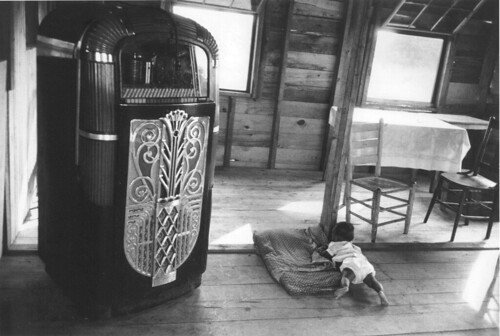"Photography is a captive of two intolerable alibis. On the one hand, 'ennobled art pictures.' On the other hand, 'reportage' which derives its prestige from the object. Neither conception is entirely correct. Photography is a Text, a complex meditation on meaning."
Consider this photograph by Robert Frank.

When I was a literature major in college, we studied ‘books,’ not ‘texts,’ but never mind. I think I take Barthe’s meaning. We almost never look at photographs outside a context. Big & gorgeous in a white-walled museum, they’re ‘ennobled.’ Under a screaming headline in a newspaper, they’re ‘real.’ In fact they’re neither. [Straight] photographs are faithful only to the patterns of light that fell on the lens that made them. One could say they’re indifferent to meaning. The viewer gives them meaning.
After looking at the picture, is your 1st response: Where is it? When? Who is the baby? Where are the grown ups? If so, you’re like most people. We’re all natural news gatherers. We want a story to make sense of what we’re seeing. OK, let’s say the picture was made on one of Frank’s cross country trips between 1955 & 1957 when he was shooting what would later become his seminal book, The Americans. Let’s say it was in a juke joint in the Arkansas delta. Frank was there in the daytime having a drink with the child’s parents, who were just outside the frame. Segregation was a fact in that place and time, so it was a fairly radical act to be there at all. He was the only white person in the place.
This might even be true.
Robert Frank is my favorite photographer. The Americans is the book that made me want to become a photographer. I’d argue that what sets his pictures apart from those of his peers is an active resistance to the kind of categorization I describe above. He doesn’t want you to take away a neat explanatory story. He wants to keep it complex, mysterious. This doesn't mean his work is esoteric. On the contrary it's about daily life. Nor is it apolitical. Frank's pictures(his early work) plunge into difference: race, region, nationality, class. They show you the real stuff. But they refuse to make it simple.
Take a look at the photo above. Frank has reduced it to the jukebox & the baby. What kind of story can you tell about that? The jukebox is like a gleaming god. Could the baby be seen as a sacrifice? The baby is healthy, active, clambering up onto the pillow. Or is the baby unsteady, about to roll off & bang its head? The room is barren & there are holes in the wall, but the floor is clean & there’s a clean tablecloth on the table? Is this about poverty or pride? Abandonment or family? Is the light that's streaming through the windows the hot milky light of a stifling Southern afternoon or is it the holy light of religious iconography?
You decide. Maybe it's all these things at once. Frank seems to want the picture to reveal its own meaning for you. He once told Life magazine: "When people look at my pictures I want them to feel the way they do when they want to read a line of a poem twice."
4 comments:
First, thanks for the link to the Avedon site. Some wonderful insights and musings from him.
What grabs me into this Frank photo is the oddness of scale and perspective. What makes me read it again is the oddness, the complexity, and the interestingness of the elements. My eye is drawn to the table, chairs, and window. I'd really like to rest over there but I keep getting pulled back by that baby. Then I try to figure the jukebox, and again I keep getting pulled back by that baby. If I focus on the baby (finally) it's posture and placement is all kinds of wrong. It's the dysharmony that makes me reread this one. Fascinating.
The best photos bring one to silence
The Tate Modern gave Frank a huge retrospective a few years ago, and then, by accident, I saw it all over again in Barcelona. I have never seen a museum- in London- so crowded with young people studiously gazing upon Frank's works. I'd had no idea how far he'd travelled in his work. He now lives in the northeast corner of Nova Scotia. We should go visit him together.
Nancy, I'm sure we wouldn't be the 1st pilgrims. I have no idea what happened to turn him away from still photos to film-making right at the moment his star was ascending, let alone what made him travel "so far...in his work." People talk about the tragedies in his life. And of course he now had the means to retreat...but I don't feel right speculating about somebody who's still very much alive & able to speak for himself. I'd go if invited.
Post a Comment